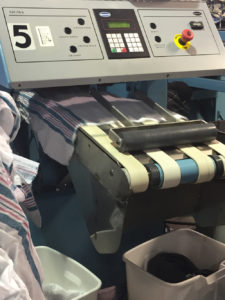 As the linen service industry has adjusted to market conditions, many changes have happened over the course of time. Several segments of the linen service industry such as Food and Beverage (where the primary business is table linen), have long been in a linen rental scenario. This has allowed the restaurant industry to be more focused on what they do best–serving food to their customers–and not have to worry about other distractions such as linen.
As the linen service industry has adjusted to market conditions, many changes have happened over the course of time. Several segments of the linen service industry such as Food and Beverage (where the primary business is table linen), have long been in a linen rental scenario. This has allowed the restaurant industry to be more focused on what they do best–serving food to their customers–and not have to worry about other distractions such as linen.
Over the past twenty years the healthcare industry has been going through a similar evolution and the ability to better utilize staff to focus on patient care has become increasingly the primary focus; services that are not directly related to the core objective have been removed, minimized, or out-sourced whenever possible. This has fostered a professional vendor environment to grow, allowing linen service businesses to become highly knowledgeable and industry responsible.
Beyond the broad history noted above, there are many specific reasons why healthcare has transitioned to a linen rental confinement we have listed below several of the offenses and reasons our customers have chosen Purity Linen as their linen rental service vendor.
Ease of Operation
- When the linen inventory is owned by the linen company (“linen rental”) the customer no longer has to spend valuable time ordering, receiving, and storing new linens. Frequently, staff persons spent significant time labeling linen with the facility’s name on a heat seal machine—a process that is no longer necessary.
- when he facility since the spikes it is not necessary to scramble for linens a place hasty And orders a call to the linen supplier to increase the next delivery is all that is necessary conversely if activity goes down a phone call fax or email to reduce the order size is typical
- the linen service now bears responsibility to call worn torn and steam linens from circulation is no longer necessary to have facility staff before mending rag duties
- during emergency situations a healthcare linen service will have proper backup equipment on site to compensate for the loss of major utilities additionally prearrangements will be made with the locations to serve as backup service in case of major need
Facility Constraints
- As healthcare customers have grown in size, they have historically looked to utilize space in the most efficient manner possible and one of the first decisions that many hospitals and long-term care facilities made was to eliminate one of the largest outsourceable cost centers – the laundry. It has been determined in nearly all scenarios that the space occupied by the laundry was more valuable in revenue potential versus the money it saved.
- As has been the case with many long-term facilities there have been significant concerns regarding the sewage discharge and many facilities that are located in more rural locales are typically outfitted with septic systems that are prohibitively expensive to enlarge or replace. The removal of the laundry can reallocate thousands of gallons a week back to usage by the residents with far lower risk of system degradation from laundry chemicals.
- Historically equipment installed in on-premise laundry may not have the ability to reach washing and drying temperatures that are required for proper disinfection and cleaning of linens as specified by healthcare standards. Our linen service has the equipment and infrastructure necessary to reach 160°F in washing and 325°F in the drying and ironing temperatures. Additionally, a linen service will have constant monitoring of the chemical composition of its linens to ensure the proper fabric pH is reached to ensure that there is minimal potential for skin reactions or bed sores.
Lower Operating Cost
- Larger processing plants and more automated equipment, while requiring greater capital investment, have greatly assisted holding or trimming annual cost increases. Increased plant productivity and lower utility expenses have kept typical market service quotations fairly near where they were a decade ago.
- Linen service company spend, literally, millions of dollars per year on purchases of new replacement linens. This purchasing power results in lower acquisition costs and can therefore be passed on to a company’s customers in replacement costs.
- Standardization of linen products and pooled production of linens have also assisted in keeping processing costs low by maintaining higher machine work area outputs than could otherwise be accomplished by “keep separate” stop-and-go operations.
Vendor Consolidation
- Since the 1990’s there have been significant reductions in consolidations of both commercial and on-premise laundry plants that process healthcare linens. This reduction in processing locations was caused by negative economic pressures in the overall healthcare industry; technological improvements in high-volume, automated processing equipment, and, therefore, larger plants; and aggressive competition.
- The remaining active regional healthcare laundries can, but not without complication, process smaller Customer-Owned Goods accounts. These larger plants process 4,000 to 8,000 pounds of linen per hour; automated equipment systems are not easily conductive to “keep separate” batch processing; multiple employee languages, reading and writing skills require simplifying operational procedures. All the major plant have transitioned to rental linen systems.